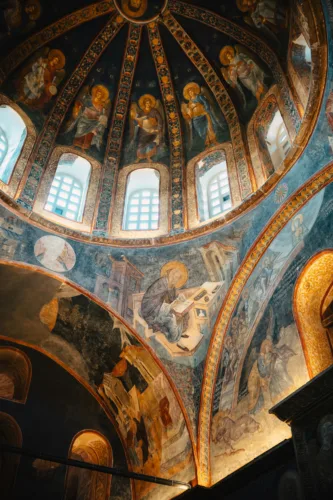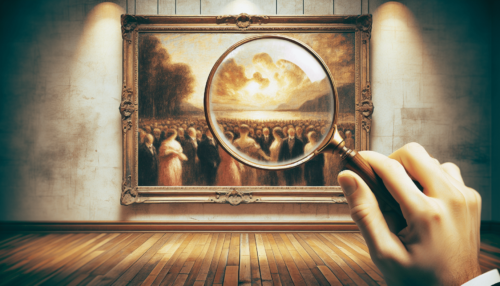Determining the artist of an artwork is an intricate process that necessitates both meticulous analysis and a keen understanding of art history. The article “How to Determine the Artist of an Artwork” delves into the methodologies and tools utilized by experts to attribute art to its rightful creator. From examining physical attributes like brush strokes and material composition to employing advanced technology such as forensic analysis and database comparison, the process is comprehensive and methodical.
It provides historical context by tracing the evolution of artist identification techniques, while also discussing current trends such as the increasing role of artificial intelligence in the field. Through detailed exploration, the article not only illuminates the scientific and analytical rigor involved in art authentication but also emphasizes the importance of preserving artistic integrity and cultural heritage. Have you ever stood before a stunning piece of art, captivated by its beauty, and wondered, “Who is the artist behind this masterpiece?” This common question opens up a vast, fascinating world of art identification, tracing the lineage and history of various art pieces back to their creators.

This image is property of images.pexels.com.
Table of Contents
Overview
Identifying the artist of an artwork is a task steeped in intrigue and intricacies. In a digital age where art from various periods and styles is widely accessible, discerning the true artist can be both a scholarly endeavor and a passionate pursuit. This process is not only crucial for art historians and collectors but also highly relevant for museums, auction houses, and the broader art market. As the value and significance of art increase, so does the importance of accurate artist attribution.
Thesis Statement
This article delves into the methodologies, historical context, and current trends in determining the artist of an artwork. By exploring various techniques, key concepts, and practical examples, readers will gain a comprehensive understanding of how art identification is conducted, its relevance in today’s art world, and its future implications.
How to Determine the Artist of an Artwork
Historical Context
Tracing the origins of artist attributions reveals a compelling history. In ancient times, many artworks were unsigned, and the concept of individual artistic authorship was often less emphasized than it is today. Medieval and Renaissance artworks were frequently collaborative efforts within workshops, further complicating modern identification efforts. The evolution of these practices influenced connoisseurs and scholars who began the rigorous processes of attribution still utilized today.
The Role of Patronage
In earlier centuries, art was often commissioned by patrons who identified and documented the artists they employed. This historical documentation has proven invaluable in attributing older artworks. For instance, during the Renaissance, the Medici family commissioned numerous works, keeping extensive records that now aid art historians.
Current Trends
In contemporary art identification, technology plays an increasingly vital role. Advanced imaging techniques and databases of artist signatures bring a scientific approach to a traditionally connoisseur-based practice. The fusion of technology with traditional art historical methods is a significant trend redefining the field.
Art Market Dynamics
The art market’s dynamic nature is another critical trend influencing artist identification. The provenance, or ownership history, of an artwork can heavily impact its market value. Accurate artist identification is thus paramount for authenticating pieces and ensuring fair market practices.

This image is property of images.pexels.com.
Key Concepts and Definitions
Provenance
Provenance refers to the documented history of an artwork’s ownership. Provenance records provide critical clues about an artwork’s origins and confirm its authenticity.
Signature Analysis
Analyzing an artist’s signature, often hidden within the artwork, is a fundamental technique in art identification. This method requires a comprehensive database of verified signatures for comparison.
Stylistic Analysis
Stylistic analysis involves examining the unique characteristics and techniques an artist employs. This method requires significant expertise in art history and familiarity with the artist’s body of work.
Technological Tools in Art Identification
Integrating cutting-edge technology has revolutionized art identification. Infrared reflectography, X-rays, and digital enhancements can reveal underdrawings, alterations, and age-related anomalies, contributing to more accurate attributions.
Detailed Exploration
Provenance Research
Provenance research involves tracing an artwork’s ownership history through sales, auctions, and exhibitions. This can uncover essential details that hint at the artist’s identity. Historical records, auction catalogs, and museum archives are crucial resources for provenance research.
Signature Analysis Methods
Artists often leave unique signatures or monograms on their work. Signature analysis includes examining the signature’s style, placement, and any accompanying inscriptions. Comparing these elements to a database of known signatures can confirm authenticity.
Stylistic Characteristics
Different artists have distinct styles and techniques that can serve as identifiers. For example, Van Gogh’s swirling brushstrokes, Picasso’s cubist forms, and Monet’s light and color play are unmistakable. Stylistic analysis requires a deep understanding of these nuances to accurately attribute artworks.
Case Study: The Arnolfini Portrait
Jan van Eyck’s “Arnolfini Portrait” is an exemplary case of successful artist identification. Detailed historical records and van Eyck’s distinctive signature – “Johannes de Eyck fuit hic 1434” (Johannes van Eyck was here, 1434) – have firmly established the painting’s provenance and authorship.

This image is property of images.pexels.com.
Technological Advancements
Infrared Reflectography
Infrared reflectography can reveal underdrawings beneath the surface of a painting, providing insights into the artist’s creative process. This technology has confirmed the attribution of many Old Master paintings.
X-Ray Fluorescence (XRF)
XRF spectrometry analyzes the elemental composition of pigments in an artwork. Understanding the materials and techniques used can help attribute a painting to a particular artist or time period.
Case Study: The Blue Period Picasso
Picasso’s “La Vie” underwent extensive technological examination, including X-ray and infrared analysis, revealing underdrawings and compositional changes. These findings not only confirmed Picasso’s authorship but also provided insight into his creative process during his Blue Period.
Comparison of Different Perspectives
Connoisseurship vs. Technological Analysis
Traditional connoisseurship emphasizes expert knowledge and visual analysis, relying heavily on the expertise of art historians. On the other hand, technological analysis brings scientific rigor and objectivity, offering data-driven insights. Both perspectives have their strengths and limitations, and combining them often yields the best results.
Evidence-Based Analysis
Evidence-based analysis, using both historical documentation and scientific methods, provides a comprehensive approach to artist identification. This synergy enhances the credibility and accuracy of attributions.

Future Directions and Implications
Predictive Analytics in Art Identification
With advancements in artificial intelligence, predictive analytics could become a game-changer in art identification. Algorithms trained on vast datasets of art characteristics might predict likely authorship with remarkable accuracy.
Broader Implications for the Art Market
Accurate artist identification impacts the entire art market landscape. It ensures authenticity, influences market value, and maintains trust in art transactions. Furthermore, it has broad implications for cultural heritage preservation and educational initiatives.
The Role of Blockchain
Blockchain technology is emerging as a revolutionary tool for provenance tracking. By providing a tamper-proof ledger of an artwork’s history, it ensures transparency and authenticity, reducing the risk of forgery.
Conclusion
Recap
Identifying the artist of an artwork is a multifaceted process that combines historical research, stylistic analysis, and cutting-edge technology. Provenance, signature analysis, and scientific methods all play critical roles. Exemplary cases, such as the “Arnolfini Portrait” and Picasso’s “La Vie,” illustrate the effectiveness of these techniques.
Final Thought
The quest to identify an artwork’s artist invites a deeper appreciation of art’s historical, cultural, and technical dimensions. As technology and methodologies evolve, so will our ability to uncover the stories behind the masterpieces adorning the world’s galleries and collections.
Engagement
Readers are encouraged to share their thoughts, experiences, or questions in the comments section, fostering an engaging and informative discussion. For further exploration, numerous resources and academic papers are available for a deeper dive into the fascinating world of art identification.

Sources
- Authoritative books and academic papers on art history and authentication
- Museum archives and historical records
- Databases of artist signatures and provenance records
- Technological research articles on infrared reflectography and XRF spectrometry.
Related site – How to Identify a Painting

